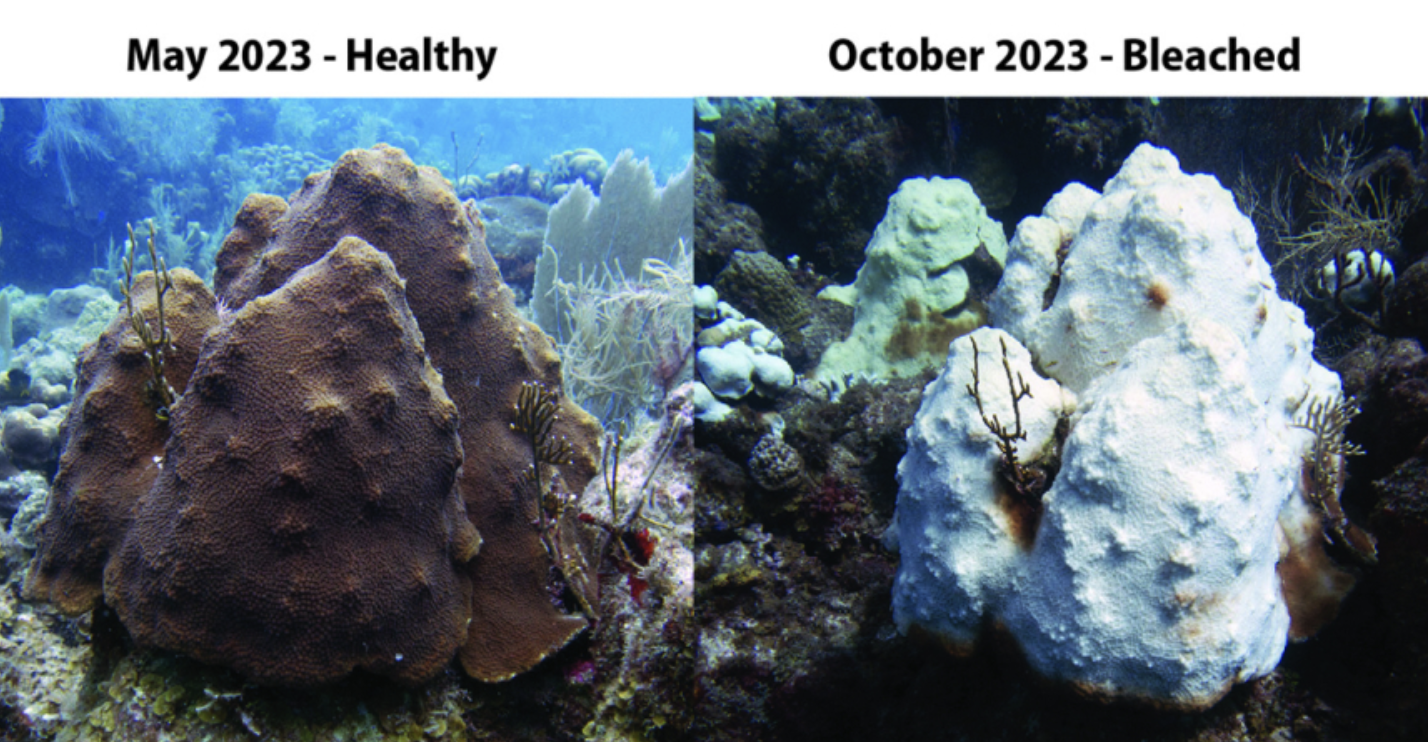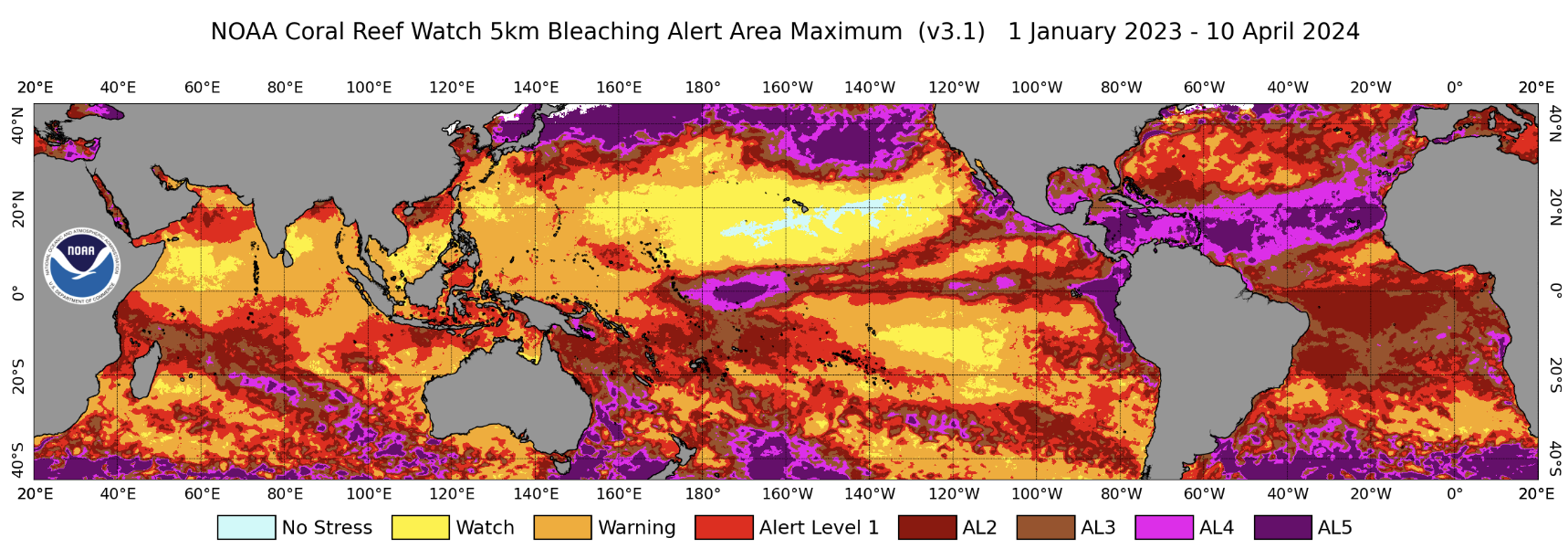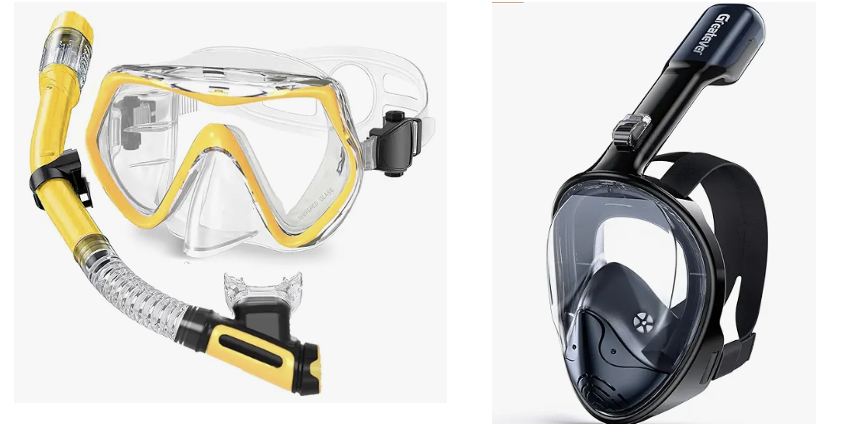If there's anything I enjoy more than snorkeling spending time with my wife, I can't think of it. So, off we were to Bermuda for five days of snorkeling. So we thought.
It's an absolutely beautiful island 600 miles off the coast of North Carolina; the people could not be friendlier or warmer. But, Bermuda's location is both fortunate and unfortunate; neither the weather nor the water is as warm as at a "traditional" Caribbean destination, such as Grand Cayman, Turks, or St. John, but this "chilly" water – 75 degrees F in June – helps protect the coral reefs from excessively high temperatures that are causing coral bleaching in some of the most famous snorkeling and diving spots in the world. Bleaching is an environmental catastrophe.
And it is not subtle. Below are photos of the same reef in St. Croix in May and again in October 2023.

Figure 1. Coral bleaching in St. Croix, USVI. Source: NOAA
But bleached coral, caused by the coral polyps expelling the algae living within them, doesn't mean that the coral is dead; it's just that it's in distress and more susceptible to death. It can recover:

The same reef 6 months later.
Coral Bleaching: It's All About Temperature
And it's widespread.

Coral Bleaching Alert Area Maximum map from NOAA's Coral Reef Watch's global satellite, between January 1, 2023, to April 10, 2024. The darker the color, the worse the bleaching. Shown are Australia, South America, and the waters adjacent to both. Not good.
The quote below makes it clear that this is a worldwide problem. Note the wide difference in location of some of the world's greatest snorkeling/diving sites that have been affected.
Since early 2023, mass bleaching of coral reefs has been confirmed throughout the tropics, including in Florida in the U.S.; the Caribbean; Brazil; the eastern Tropical Pacific (including Mexico, El Salvador, Costa Rica, Panama and Colombia); Australia’s Great Barrier Reef; large areas of the South Pacific (including Fiji, Vanuatu, Tuvalu, Kiribati, the Samoas and French Polynesia); the Red Sea (including the Gulf of Aqaba); the Persian Gulf; and the Gulf of Aden.
NOAA confirms 4th global coral bleaching event, April 2024
It takes an increase in water temperature of only about 1-2oC, which can be caused by a heat wave, to trigger a bleaching event. Preventing this destruction is the goal of an enormous global effort in which scientists are conducting a sweeping assortment of research approaches, including 3D printing of artificial coral, laboratory cultivation of seedling coral, breeding of heat-resistant variants, and even manipulating low-lying clouds to make them more effective in blocking the sun.
The World's Most Precious Poop?
If you're walking on a beach surrounded by coral reefs, the chances are that you are walking on fish poop, but not just from any fish. Parrotfish, some of the reef's most spectacular denizens, "make" the beach by munching on the algae of coral reefs. During this process, the fish also bites off and ingests some of the coral. Following digestion, it poops out pure white "sand." If you think it requires a special set of chompers to subsist on coral, you're dead on. A single parrotfish can produce hundreds of pounds (!) of sand per year.

Two of ~100 known species of parrotfish. (Left) Rainbow Parrotfish (Flickr). (Right) Stoplight Parrotfish (Wikimedia Commons)
Snorkeling can be dangerous
Floating on the surface of a gentle lagoon may sound like a leisurely, carefree afternoon, but this is not necessarily the case. The leading cause of tourist death in Hawaii is drowning (very few locals drown), and snorkeling is by far the leading cause of drowning. But deaths attributed to drowning can be from something else called Rapid Onset Pulmonary Edema (ROPE) – a dangerous condition in which the alveoli (the tiny air sacs in the lungs) fill with fluid instead of air, causing pulmonary edema.
Underlying causes of ROPE include heart and respiratory disease, but it has also been linked to flying. A family is suing Hawaii for the May 2022 death of Ray Johnson, who was snorkeling in Maui, claiming that Hawaii did not properly educate visitors about the risk of ROPE. This may be nothing more than a money grab since the Johnsons were experienced snorkelers who had already visited Maui six times and had "snorkeled [there] many times in the past." Sounds fishy.
Snorkelgate
There is also some controversy about the safety of full-face snorkels vs the traditional design.

(Left) A traditional two-piece snorkeling set. (Right) A full-face snorkel.
The Turks and Caicos traveling guide has taken an official position on mask choice, warning that full-face masks are dangerous because too much carbon dioxide builds up in them compared to traditional two-piece snorkels. The difference is in the dead space (2): A normal snorkel has a dead space volume of 160 mL. Full-face masks range from 250 to 1,470 mL; rebreathing carbon dioxide is clearly a bigger threat in these masks.
The primary and overriding concern with full face masks is CO2 build up in the mask. Humans exhale carbon dioxide (CO2) when they breathe, and this CO2 can collect in the voids inside the mask when being used in the water. When CO2 levels increase in the mask, users may experience headaches, panic, dizziness, and unconsciousness, which of course can be life-threatening when experienced in the water
However, companies that sell them, for example, here and here on Amazon, claim otherwise. In my opinion, I'll take good snorkeling equipment, which can cost hundreds of dollars, over the full-face mask any day.
Snorkeling is not for everyone
I should have seen this coming. My long-suffering wife also suffers from motion sickness. Who knew that this would rear its ugly head in the water? Well, we found out after floating for 15 seconds in "waves," possibly capable of capsizing a tongue depressor. Suffice it to say that I had plenty of "me" time on this trip.
Trip report
Bermuda is absolutely gorgeous, spotless, and welcoming. The snorkeling is good – not great (1) – and there are many different reefs to try, some more sheltered than others; the water is beautiful and clear in most places. Just don't go there looking for a bargain. It is scary-expensive, and saving money by going off-season isn't a great option. The water is too chilly for most swimmers before June, when "the season" officially begins.
NOTE:
(1) To get spectacular, one needs to snorkel on the outside of the reefs and (the open ocean side). Expect to get tossed around, and the currents can be strong. You'd have to be an idiot to go out there alone. I plead guilty.
(2) Dead space in a snorkel refers to the portion of the snorkel tube where exhaled air remains and gets re-inhaled during the next breath.




